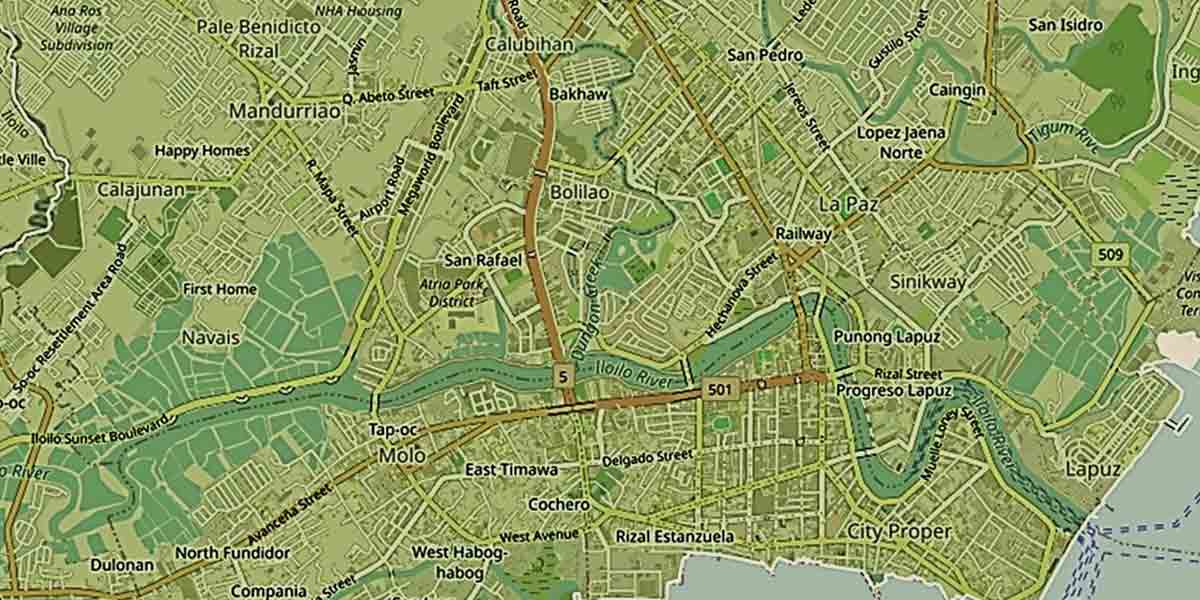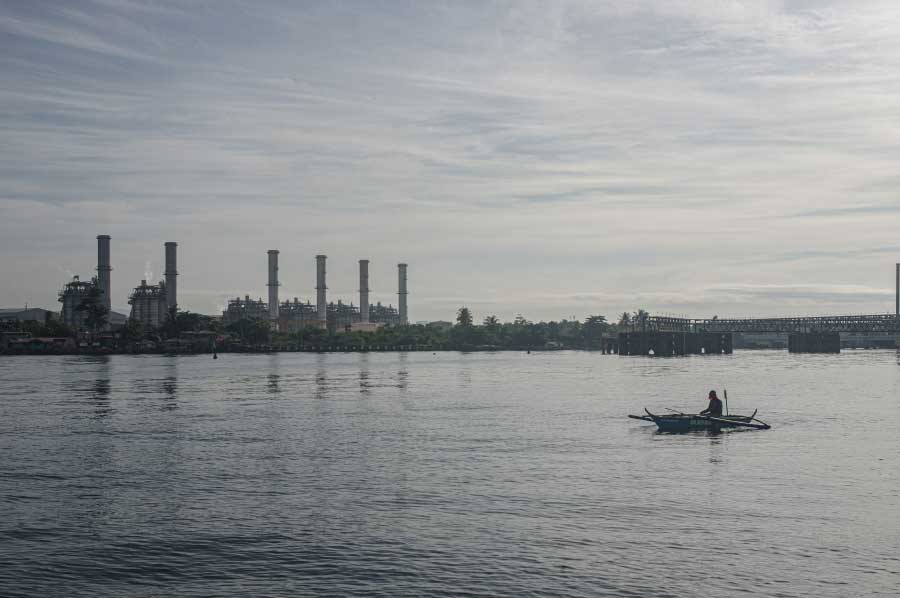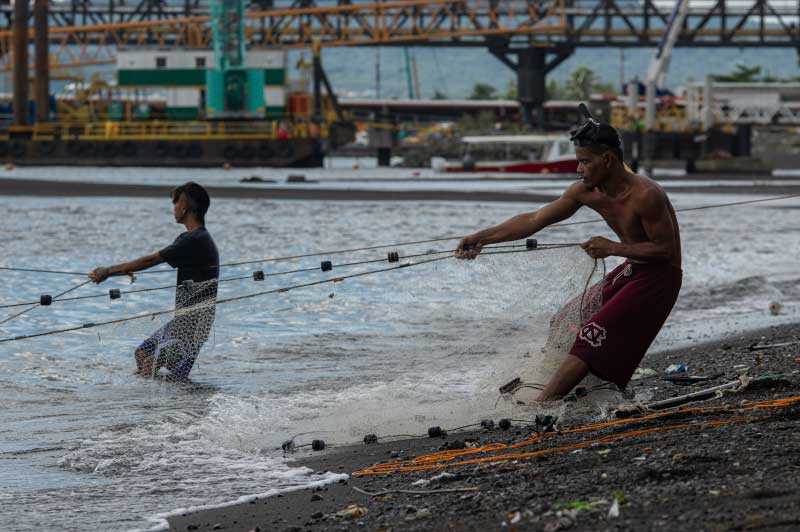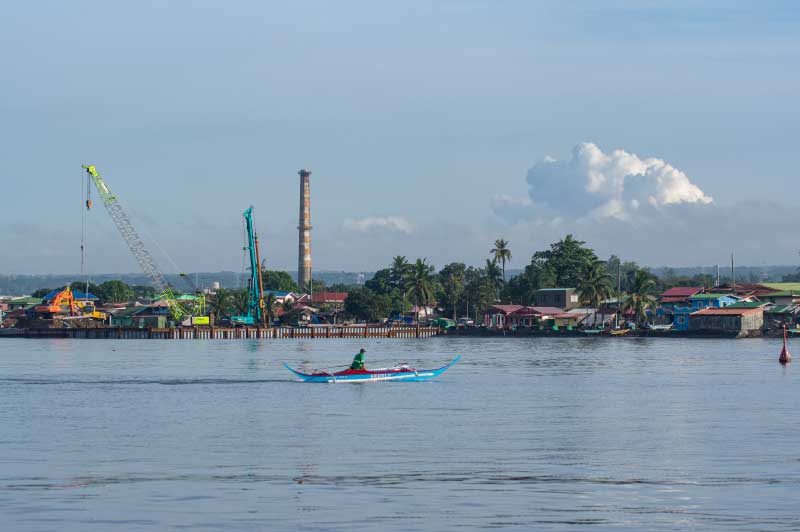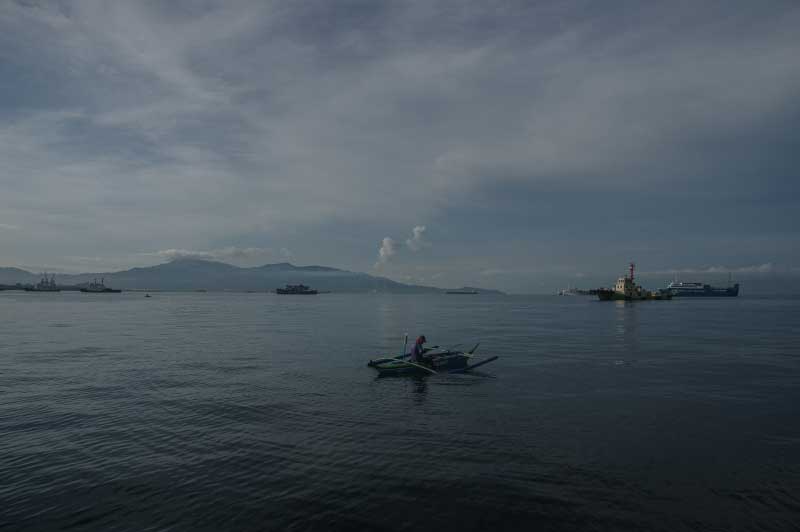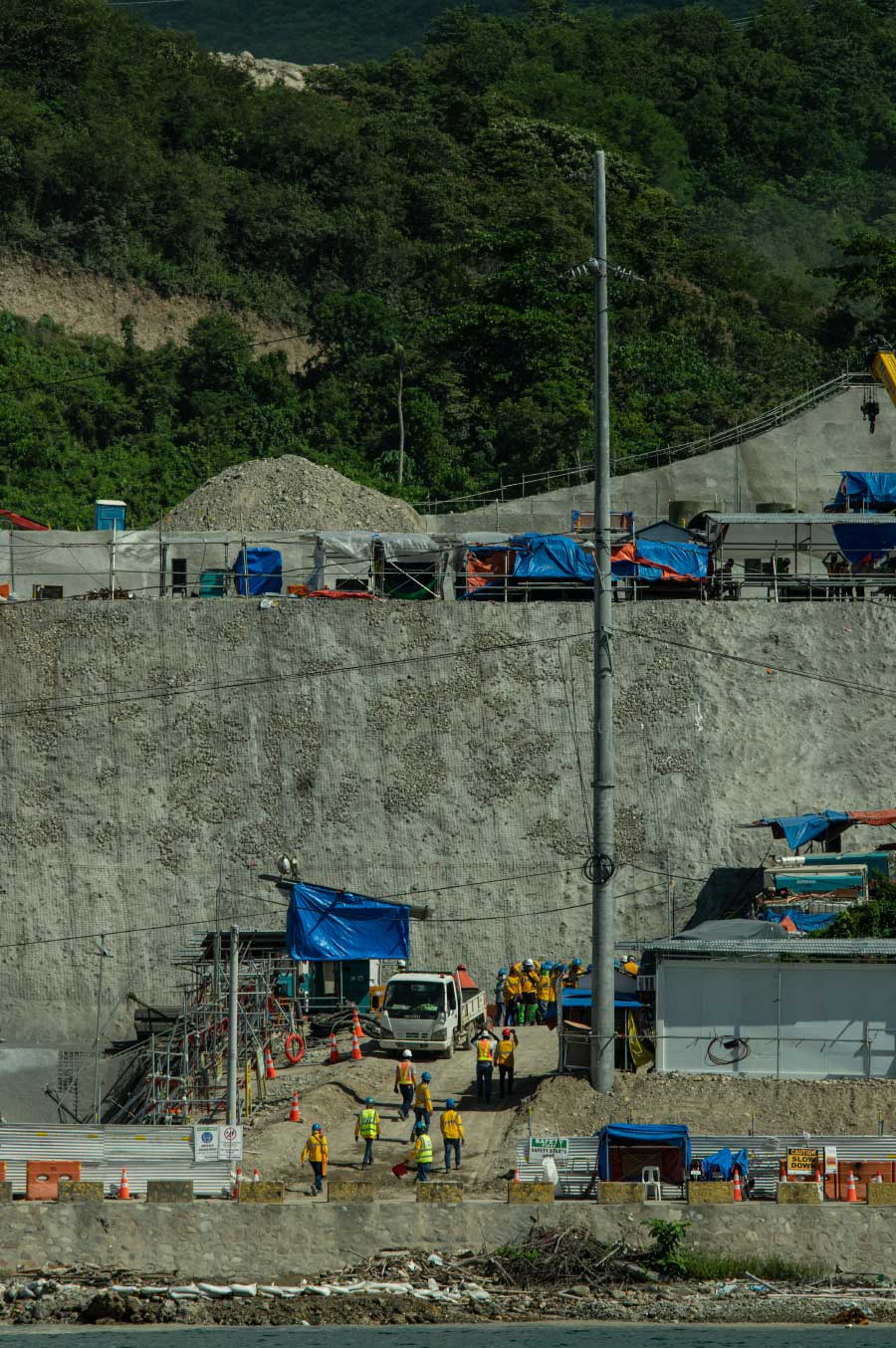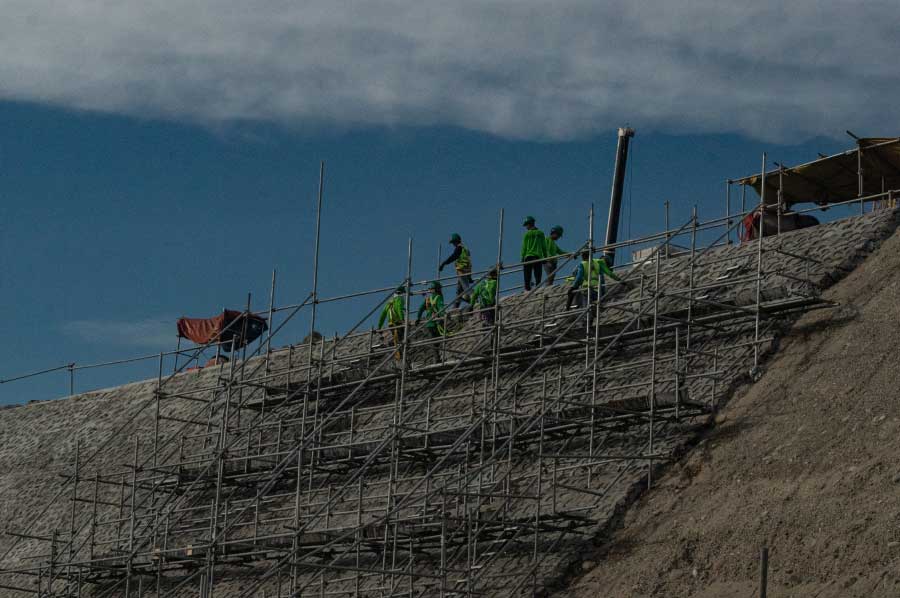
By Cherry Salazar
Philippine Center for Investigative Journalism
Second of three parts
Gas projects destroy way of life in Batangas fishing communities.
BATANGAS CITY — Fishing used to be the main livelihood of residents in Ilijan, a coastal barangay (village) in southern Batangas province. That was until two decades ago when a natural gas-fired power plant began operations.
Now, only 19 of the 4,880 residents in the community are fishermen. Among them is 68-year-old Raymundo Cepillo.
For generations, the Cepillos have relied on the bounty of the sea. But Raymundo believes the family trade would end with him as none of his children took a liking for it. Apart from him, the only fishermen in the family are his cousin and nephew.
“Kaming nalaot ngayon, mga senior (Only the seniors are going out to sea),” he said. “‘Yung mga bata, nagtatrabaho (sa ibang lugar) (The young ones work [elsewhere]).”
Even then, none of the three Cepillo fishermen saw it as a full-time job as they mainly worked in construction. Occasionally, they would unmoor their boats so they could have fresh catch to cook and eat. Otherwise, they would have to go to the market and buy fish hauled from Palawan, a province some 700 kilometers away.
Raymundo pointed out the irony: Right outside their home in Batangas City is a portion of the world’s most biodiverse marine corridors, the Verde Island Passage, also known as the “Amazon” of the oceans, yet they were getting their fish from elsewhere. (Read PCIJ related story: Verde Island Passage in danger as LNG projects flock to Batangas.)
Photo 2: Raymundo and Juan Cepillo

Two more gas projects are being built in the Cepillos’ village: Linseed Field Corp.’s import facility for liquefied natural gas (LNG), which include floating storage and onshore regasification units, and SMCGP subsidiary Excellent Energy Resources, Inc. (EERI)’s 1,700-megawatt natural gas-fired power plant.
In nearby Sta. Clara, another coastal village in Batangas City, fisherfolk suffered from fewer catch as well. They attributed this to the ongoing construction of FGEN LNG Corp.’s floating storage and regasification unit. Also within the community’s vicinity are four existing natural gas-fired power plants, all owned by parent company First Gen Corp.

In an email to PCIJ, First Gen corporate communications head Ricky Carandang said the Lopez family-owned power producer was “open to discussing any specific concerns” with affected residents, adding that the company held quarterly information, education, and communication (IEC) sessions with the community.
Following a discussion with fisherfolk, FGEN “donated motor pump boats to increase their ability and flexibility to catch and sell fish,” Carandang said.
Linseed’s and FGEN’s facilities are two of seven ongoing LNG terminal projects meant to address the incoming energy shortfall and make the country less reliant on coal. The gas field at Malampaya off the coast of Palawan is expected to be depleted as early as 2024. These developments are also part of the plan to position the Philippines as Southeast Asia’s hub for LNG.
Environmentalists warn that the cost for the environment and community could outweigh the supposed benefits for the energy sector. At the local level, gas projects like the Ilijan plant yield revenues that host communities can use for their needs. But in the face of these developments, the once thriving fishing community is gone. The fisherfolk who remain are left to fend for themselves.
Power facilities, like most big projects, are considered critical to the environment, thus requiring proponents to assess impacts and come up with plans to mitigate them. While these mitigation measures include employment opportunities and skills training for residents, they are mostly short-term, and as the projects industrialize the host community, some residents, like the Cepillos, get left behind.
Dwindling catch
Ilijan fishers used to haul 10 to 20 kilograms of galunggong (round scad) and tulingan (frigate tuna) in a half-hour fishing trip. When they were lucky, they caught as much as 51 kilograms of these and the rarer tanigue (Spanish mackerel).
It’s been years since this last happened. Now, months would pass when they would have few to no catch at all.
“Noong wala pang planta ay medyo madali ang isda dito. Magpalaot ka lang, may isda na… Parang nabawasan noong magka-planta, parang isda ay nawala (Catch was easy when there was no power plant yet. You don’t even have to go so far… Since the plant was built, we saw fewer fish),” Juan said.
In the last decade, fish production volume of both galunggong and tulingan across Batangas province went on a steady decline, according to data from the Bureau of Fisheries and Aquatic Resources. Galunggong catch decreased by more than half to 1,039 metric tons in 2022 from 3,224 metric tons in 2012. It was the same for tulingan – the volume dropped to 1,015 metric tons in 2022 from 2,168 metric tons in 2012.

The Batangas coast is one of 24 major fishing grounds in the Philippines. The province is the 16th top fish producer by volume in the country, excluding Metro Manila, as of 2021. But it also recorded the third biggest drop in production from 2019 to 2021.
Kepco, the proponent of the existing Ilijan Power Plant, stated in its environmental impact statement (EIS) submitted to the environment department in 1998 that “temporary and minor disruption of fishing activities” could be anticipated during the construction.
But it would not reduce the income of fisherfolk, Kepco claimed, “since they can move to the adjacent and equally productive fishing grounds… where fish are abundant.” Kepco promised that construction would not coincide with fishing activities.
Kepco’s EIS did not mention how fisherfolk and their catch would be affected during the plant’s original 20-year contract period.

Limited fishing grounds
Aside from poor catch, the fisherfolk also lamented fishing restrictions due to the ongoing construction projects.
Linseed proposed an exclusion zone of 500 meters from its floating storage unit (FSU) for the construction, operation, and maintenance of its facilities. The firm also sought an additional 200 meters as a safety zone, where some activities may be prohibited without prior consent from authorities, for re-supply and ship maneuvering.
These are apart from the exclusion zone of the adjacent EERI power plant bordering Ilijan and Dela Paz villages, which extends 20 meters from the shoreline to the sea and about 225 meters parallel to the shore. According to its EIS, this exclusion zone will enclose the intake and outfall pipelines of the cooling water system, the pier, and the jetty.

“Maraming isda doon. ‘Yun ang nakikita kong magiging malaking kawalan ng mangingisda (We catch plenty of fish in those areas. That will be a big loss to fisherfolk),” said Nanding Daquis, who leads the Ilijan fisherfolk association.
When these projects become operational, even line fishing would be dangerous due to vessel activities, Raymundo said. “Hindi ka puwedeng mangawil doon, baka ika’y mabangga doon (You should not fish there because ships might hit you).”
Fishers’ access to the area and the project’s impact on their livelihood were raised during Linseed’s public scoping and consultation in September 2020 and April 2021, respectively, its EIS showed.
Batangas City administrator Engr. Januario “Sonny” Godoy, who attended Linseed’s public consultations when he was the city planning and development officer, told PCIJ the restrictions were needed as a security breach could become a national security concern.
“Kasi oras na magkaroon diyan (power facilities) ng problema, ma-infiltrate iyan ng mga… masasamang-loob na gusto i-sabotage ang ating ekonomiya, maaapektuhan ang flow ng ating electricity at malamang titigil ang ekonomiya ng Pilipinas (When power facilities are infiltrated by lawless groups, the country’s economy will be sabotaged as it will affect the flow of electricity in the Philippines),” said Godoy, who was previously a member of the multipartite monitoring team for Lopez-owned natural gas power plants in Batangas City.
While Godoy admitted that the restricted areas were good fishing grounds, he chided fishers for demanding access to the perimeter.
“Open ‘yung Batangas Bay for fishing. Tapos puwede pa silang pumunta beyond that, puwede pa silang pumunta sa may dagat papuntang Mindoro… Ang gusto kasi nila, gusto nilang mangisda dito lang sa may tabi. Hindi nga puwede kasi nga restricted nga ‘yung area (Batangas Bay is open for fishing. They can even go beyond that, toward Mindoro province… But what they want is to fish nearby, which can’t be allowed because the area is restricted),” said Godoy.
But longer fishing trips meant more fuel expenses, which the fishers might not even recoup with their catch.
“Pagka gustong dumami ang huli, doon pa pupunta, malayo. Ang gastos naman, wala nang gasolina (If we want to bring home more catch, we have to go farther. That will be more expensive due to the fuel required),” Raymundo said. “E di tiis (What else can we do but endure?)”
Photo 3: Sta. Clara fishers
Short-lived benefits
In Linseed’s impact management plan presented during a public hearing in February 2021, fisherfolk whose livelihood and income source would be affected by the restrictions were to be given “just compensation and relocation package,” alternative livelihood training, and fishery and fisher-based livelihood programs.
Raymundo and Juan told PCIJ that the most assistance they received as of September 2022 were relief goods or ayuda from the local government. PCIJ sought to interview representatives of Linseed or its parent company Atlantic, Gulf & Pacific Company of Manila, Inc. (AG&P), and EERI or its parent company SMCGP, but has yet to receive a response as of posting.
PCIJ could not obtain information on the assistance provided by Kepco to Ilijan residents when it operated the gas plants from 2002 to 2022.
In an ambush interview, Barangay Ilijan Chairman Gilbert Cepillo told PCIJ that employment opportunities, such as construction work, were among the benefits the community enjoyed from LNG projects.
“Sa pagtatayo [niyan], mabigyan ng trabaho ‘yung mga taong mga walang trabaho dito sa amin, nagkaroon ng oportunidad na matuto ng iba’t ibang mga hanapbuhay, ma-enhance nila ‘yung kanilang [expertise] sa dati nilang field ng kanilang pinagtatrabahuan (Because of [those projects], residents are given jobs and opportunities to enhance their industry skills),” he said. (Read PCIJ related story: Barangay chairman works for LNG plant in Ilijan, Batangas.)
DOE estimated that the approved LNG terminal projects in Batangas so far would yield at least 3,137 jobs: 2,765 during construction and 372 during operation. Across the country, all the projects would result in least 3,707 jobs: 3,265 during construction and 442 during operation.
Photo 4: Construction workers
Even then, other barangay officials acknowledged that construction projects were only temporary.
“Isa sa source ‘yun ng hanapbuhay pero di naman stable diyan e, dahil pag [construction phase lang]. Pagkatapos ng ganyan, nag-abroad na sila (Construction work is a common livelihood among residents but it is not stable because it is only available during the construction phase of a project. Once the infrastructure is built, residents would find work overseas),” barangay council member Eric Landicho told PCIJ.
By the time operations begin, facilities would hire employees, such as engineers, from outside the village for specialized work, said barangay secretary Nellie Bool.
City administrator Godoy said that aside from employment opportunities, projects also brought “secondary downstream livelihood opportunities” for residents, such as operating boarding houses and small stores.
Tax surge from LNG projects
Power facilities also pay hefty taxes to the local government. Batangas City officials confirmed to PCIJ in January 2023 that FGEN was among its top 20 real estate taxpayers in 2022, while the four existing natural gas power plants in Batangas City, also owned by First Gen, were among the top 20 business taxpayers in 2022.
Kepco, which operated the Ilijan Power Plant for two decades, was among the top 10 business taxpayers in the city in 2015, while its new operator SPPC is among the top 20 business taxpayers in 2022.
Neither Linseed nor EERI, both of which are still constructing their gas facilities, made it to the list of top taxpayers.
Host communities, from the barangay to the regional levels, also get a share of revenues, as mandated by the implementing rules and regulations of Republic Act No. 9136, or the Electric Power Industry Reform Act (EPIRA), and Energy Regulation No. 1-94.
Under government regulations, one centavo per kilowatt-hour (Php 0.01/kwh) of the total electricity sales must be allocated to the host community.
For a non-highly urbanized city, such as Batangas City, the allocation is divided as follows: electrification fund (Php 0.005), development and livelihood fund (Php 0.0025), and reforestation, watershed management, health and environment enhancement fund (Php 0.0025).
“Milyon na ‘yung na-generate na pondo at milyon na rin ang projects na napagawa ng barangay, ng city, at ng province (Millions of pesos in funding were generated and millions of projects had been implemented through these projects at the barangay, city, and provincial levels),” Godoy told PCIJ. “At ‘yun namang share ng Calabarzon region ay ‘yun ang ibinibigay nila sa iba-ibang probinsya o bayan na hindi naman nagho-host ng power plant (The fund share of Calabarzon region was distributed to provinces and communities that do not host power plants).”
At the height of the pandemic, host communities were able to draw these funds for their local response under the Department of Energy (DOE) Circular No. 2020-04-0008. The funds were allocated to emergency subsidies, mass testing-related costs, and protective equipment for health frontliners, among others. According to DOE data, total remittances reached P4.6 billion covering the period September 2019 to July 2021.
With more LNG projects lined up, the local government is expecting more revenues.
Five of the so far seven approved LNG terminal projects and two of three committed gas-fired power plants are in Batangas City, according to the DOE. This does not include other LNG projects in the pipeline.
Those whom progress neglects
To residents of Ilijan, there was no question that their standard of living improved after the power facilities were built.
In the past, they needed to schedule trips to the city center via motorized boats. The roads have since been paved and widened. Sons and daughters of residents were also able to earn college degrees and become salaried employees. Homes made of cement replaced their wooden houses, and new businesses sprouted.
Amid continued progress in their village, fishers have accepted that their better days were long gone.
“Mas maganda ‘yung naging benepisyo ngayon dahil marami ang natutulungan. ‘Yung katulad namin, e di hanggang doon laang (The benefits were worth it because they helped many residents. For us fishermen, there’s nothing more we can do about it),” Juan said. “Pagka hanggang doon ka lang, kahit ano’ng gawin mo, hanggang doon ka lang (Whatever we do, that’s all there is for us).”
“If LNG projects were to be stopped, what would happen to those who benefit from them?” asked Raymundo in Filipino. “Mas marami ang nagtatrabaho dine sa hindi… Matatanda na naman kami, e di dito na laang ako sa tabi (There are more residents benefiting from employment opportunities provided by the projects than those who do not. We’re past our prime anyway, so we won’t stand in the way).
This may spell the end of fishing in Ilijan, with the younger generation disinterested in the trade and more residents preferring manual labor, salaried employment, and work overseas.
“Walang mahuli at mataas ang konsumo (ng gasolina). Ang iba, hindi na nag-restore ng bangka nila. Parang umayaw na sila sa pangingisda (Fish are few and [fuel prices] are soaring. Other fishers decided not to restore their boats anymore. It’s as if they have given up on fishing),” said Daquis.
“Kaya paubos na kami (We’re almost gone),” he said. –With research by Martha Teodoro and Elyssa Lopez, PCIJ, March 2023


